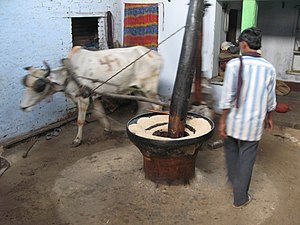Mustard oil/ja: Difference between revisions
Created page with "===規制=== 米国食品医薬品局は、高エルカ酸含有量のため、米国での料理用圧搾マスタードオイルの輸入または販売を禁止している。対照的に、FDAはエルカ酸含有量がはるかに低い精油マスタードオイルを一般的に安全と認められるとして分類しており、食品への使用を許可している。圧搾マス..." |
Created page with "アリルイソチオシアネートは、植物にとって草食動物に対する防御として機能する。植物にとって有害であるため、それは無害なグルコシノレートの形でミロシナーゼ酵素とは別に貯蔵されている。草食動物が植物を噛むと、有害なアリルイソチオシアネートが生成される。アリルイソチオシアネートは、horseradish/ja|ホー..." Tags: Mobile edit Mobile web edit |
||
| (3 intermediate revisions by 2 users not shown) | |||
| Line 25: | Line 25: | ||
[[:en:U.S. Food and Drug Administration|米国食品医薬品局]]は、高エルカ酸含有量のため、米国での料理用圧搾マスタードオイルの輸入または販売を禁止している。対照的に、FDAはエルカ酸含有量がはるかに低い精油マスタードオイルを[[:en:generally recognized as safe|一般的に安全と認められる]]として分類しており、食品への使用を許可している。圧搾マスタードオイルは、米国では「外用のみ」という表示が義務付けられた[[massage oil/ja|マッサージオイル]]として許可されている。 | [[:en:U.S. Food and Drug Administration|米国食品医薬品局]]は、高エルカ酸含有量のため、米国での料理用圧搾マスタードオイルの輸入または販売を禁止している。対照的に、FDAはエルカ酸含有量がはるかに低い精油マスタードオイルを[[:en:generally recognized as safe|一般的に安全と認められる]]として分類しており、食品への使用を許可している。圧搾マスタードオイルは、米国では「外用のみ」という表示が義務付けられた[[massage oil/ja|マッサージオイル]]として許可されている。 | ||
==栄養{{Anchor|Nutrition}}== | |||
==Nutrition== | マスタードオイル(100gあたり)は、884[[:en:calorie|カロリー]]の食品エネルギーを含み、100%が[[fat/ja|脂肪]]である。脂肪組成は、[[saturated fat/ja|飽和脂肪酸]]11%、[[monounsaturated fat/ja|一価不飽和脂肪酸]]59%、[[polyunsaturated fat/ja|多価不飽和脂肪酸]]21%である。 | ||
==精油{{Anchor|Essential oil}}== | |||
[[Mustard (condiment)/ja|マスタード(調味料)]]の辛味は、粉砕したマスタードシードを[[water/ja|水]]、[[vinegar/ja|酢]]、その他の液体と混ぜる(あるいは噛む)ことによって生じる。この条件下で、クロガラシ(''[[Brassica nigra/ja|Brassica nigra]]'')またはブラウンインディアンマスタード(''[[Brassica juncea/ja|Brassica juncea]]'')の種子に含まれる[[enzyme/ja|酵素]][[myrosinase/ja|ミロシナーゼ]]と[[glucosinolate/ja|グルコシノレート]]の一種である[[sinigrin/ja|シニグリン]]との化学反応により、[[allyl isothiocyanate/ja|アリルイソチオシアネート]]が生成される。[[distillation/ja|蒸留]]により、92%以上のアリルイソチオシアネートを含む非常に辛味の強い[[essential oil/ja|精油]](「揮発性マスタード油」と呼ばれることもある)を生成できる。アリルイソチオシアネートの辛味は、感覚ニューロンの[[TRPA1/ja|TRPA1]]イオンチャネルの活性化によるものである。ホワイトマスタード(''[[Brassica hirta/ja|Brassica hirta]]'')はアリルイソチオシアネートではなく、[[sinigrin/ja|シニグリン]]から分解される[[sinalbin/ja|シナルビン]]由来のより穏やかな[[4-Hydroxybenzyl isothiocyanate/ja|4-ヒドロキシベンジルイソチオシアネート]]を生成する。 | |||
{{ | |||
アリルイソチオシアネートは、植物にとって[[:en:Plant defence against herbivory|草食動物に対する防御]]として機能する。植物にとって有害であるため、それは無害なグルコシノレートの形でミロシナーゼ酵素とは別に貯蔵されている。草食動物が植物を噛むと、有害なアリルイソチオシアネートが生成される。アリルイソチオシアネートは、[[horseradish/ja|ホースラディッシュ]]や[[wasabi/ja|ワサビ]]の刺激的な味の原因でもある。それは合成的に生産することもでき、「合成マスタードオイル」として知られることもある。 | |||
==関連項目== | ==関連項目== | ||
Latest revision as of 20:42, 13 June 2025

マスタードオイルは、食用に圧搾された油、またはマスタード植物の刺激的な精油(揮発性油とも呼ばれる)のいずれかを意味する。精油は、マスタードシードを挽き、挽いたものを水と混ぜ、結果として生じる揮発性油を蒸留によって分離することで得られる。また、種子の乾留によっても生産できる。圧搾されたマスタードオイルは、一部の文化圏では食用油として使用されている。しかし、エルカ酸の含有量が高いため、一部の国では販売が制限されている。エルカ酸含有量の低いマスタードシードの変種が栽培された時期もある。
歴史
マスタードオイルは、現代のイスラエルにある古代ユダヤの町フコックで生産されていた可能性が高い。これは、急勾配の半円形のワイン桶や低い溝など、そこで見つかった特徴的な農業施設によって示唆されている。学者たちは、ローマ時代またはビザンツ時代に遡るこれらの構造が、マスタードの莢を 潰して油を製造するために使用されたと考えている。フコックでのマスタード生産は、エルサレム・タルムードにも記録されている。
圧搾油

油はマスタードシードの約30%を占める。これは、クロガラシ(Brassica nigra)、ブラウンマスタード(B. juncea)、ホワイトマスタード(B. alba)から生産できる。
料理での使用
独特の刺激的な風味を持つこの油は、主にアッサム料理、ベンガル料理、ネパール料理、北インド料理、そしてバングラデシュ料理で特徴的に使用されている。時折、ギーの代用品としても使われる。
化学組成
その刺激的な風味は、マスタード科(アブラナ科)植物(例えば、キャベツ、ホースラディッシュ、ワサビ)のファイトトケミカルであるアリルイソチオシアネートに由来する。
マスタードオイルは、約60%の一価不飽和脂肪酸(エルカ酸42%、オレイン酸12%)、約21%の多価不飽和脂肪酸(オメガ-3のα-リノレン酸6%、オメガ-6のリノール酸15%)、そして約12%の飽和脂肪酸を含んでいる。
キャノーラ油中のエルカ酸
マスタードオイルは最大50%のエルカ酸を含むことがある。エルカ酸はキャノーラ油の成分であり、エルカ酸レベルが総脂肪酸の2%を超えず、キャノーラ油が純粋である場合、ヒトが摂取しても安全な食品成分とみなされている。
規制
米国食品医薬品局は、高エルカ酸含有量のため、米国での料理用圧搾マスタードオイルの輸入または販売を禁止している。対照的に、FDAはエルカ酸含有量がはるかに低い精油マスタードオイルを一般的に安全と認められるとして分類しており、食品への使用を許可している。圧搾マスタードオイルは、米国では「外用のみ」という表示が義務付けられたマッサージオイルとして許可されている。
栄養
マスタードオイル(100gあたり)は、884カロリーの食品エネルギーを含み、100%が脂肪である。脂肪組成は、飽和脂肪酸11%、一価不飽和脂肪酸59%、多価不飽和脂肪酸21%である。
精油
マスタード(調味料)の辛味は、粉砕したマスタードシードを水、酢、その他の液体と混ぜる(あるいは噛む)ことによって生じる。この条件下で、クロガラシ(Brassica nigra)またはブラウンインディアンマスタード(Brassica juncea)の種子に含まれる酵素ミロシナーゼとグルコシノレートの一種であるシニグリンとの化学反応により、アリルイソチオシアネートが生成される。蒸留により、92%以上のアリルイソチオシアネートを含む非常に辛味の強い精油(「揮発性マスタード油」と呼ばれることもある)を生成できる。アリルイソチオシアネートの辛味は、感覚ニューロンのTRPA1イオンチャネルの活性化によるものである。ホワイトマスタード(Brassica hirta)はアリルイソチオシアネートではなく、シニグリンから分解されるシナルビン由来のより穏やかな4-ヒドロキシベンジルイソチオシアネートを生成する。
アリルイソチオシアネートは、植物にとって草食動物に対する防御として機能する。植物にとって有害であるため、それは無害なグルコシノレートの形でミロシナーゼ酵素とは別に貯蔵されている。草食動物が植物を噛むと、有害なアリルイソチオシアネートが生成される。アリルイソチオシアネートは、ホースラディッシュやワサビの刺激的な味の原因でもある。それは合成的に生産することもでき、「合成マスタードオイル」として知られることもある。
関連項目
| この記事は、クリエイティブ・コモンズ・表示・継承ライセンス3.0のもとで公表されたウィキペディアの項目Mustard oil(31 May 2025, at 02:31編集記事参照)を翻訳して二次利用しています。 |